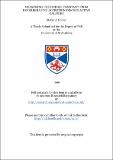Files in this item
Measuring the Hubble constant from reverberating accretion discs in active galaxies
Item metadata
| dc.contributor.advisor | Horne, K. (Keith) | |
| dc.contributor.author | Collier, Stefan J | |
| dc.coverage.spatial | 168 p. | en_US |
| dc.date.accessioned | 2018-06-25T09:39:09Z | |
| dc.date.available | 2018-06-25T09:39:09Z | |
| dc.date.issued | 1999 | |
| dc.identifier.uri | https://hdl.handle.net/10023/14517 | |
| dc.description.abstract | The standard paradigm of active galactic nuclei (AGN) postulates that their luminosity, L ~ 10³⁹⁻⁴⁸erg s⁻¹, derives from the accretion of gas onto a supermassive black hole, mass M ~ 10⁶⁻⁹M☉, at the centre of a host galaxy. Echo or reverberation mapping affords a method of relating flux variations at different wavelengths to determine the nature of the flux emitting regions, with μ-arcsecond resolution. The results of an intensive two-month campaign of ground based spectrophotometric monitoring of the Seyfert 1 galaxy NGC 7469, with a temporal resolution of ≤1 day, are presented. Application of echo mapping techniques reveal the virial mass of the central source to be MNGC 7469 ~10⁶⁻⁷ M☉, and a compact broad Balmer line emitting region ~ 5 light days from the central source. Together, this evidence suggests the existence of a supermassive black hole in NGC 7469. Further, evidence for significant wavelength- dependent continuum time delays is presented, with optical continuum variations lagging those at UV wavelengths by about 1-2 days. The wavelength-dependent time delays, (λ), are consistent with the predicted T ∝ λ ⁴/ ³ relationship for an irradiated blackbody accretion disc with temperature structure T(R) ∝ R⁻³/⁴ and hence may represent the indirect detection of an accretion disc structure in NGC 7469. It is shown that wavelength-dependent time delays test the standard black-hole accretion disc paradigm of AGN, by measuring T(R) of the gaseous material surrounding the purported black hole. Moreover, a new direct method is presented that combines observed time delays and the spectral energy distribution of an AGN to derive a redshift-independent luminosity distance; assuming the observed time delays are indeed due to a classical accretion disc structure. The luminosity distance permits an estimate of the Hubble constant, H₀-the expansion rate of the Universe. The first application of the method yields H₀(cos i/0.7)¹/² = 38 ± 7km s⁻¹ Mp ⁻¹. A more accurate determination of H₀ requires either an independent accurate determination of the disc inclination i or statistical average of a moderate sample of active galaxies. This method permits determination of redshift-independent luminosity distances to AGNs, thereby, giving a new route to H₀, and by extension to fainter objects at z ~ 1, q₀. | en_US |
| dc.language.iso | en | en_US |
| dc.publisher | University of St Andrews | |
| dc.subject.lcc | QB981.C7 | |
| dc.subject.lcsh | Cosmology | en |
| dc.title | Measuring the Hubble constant from reverberating accretion discs in active galaxies | en_US |
| dc.type | Thesis | en_US |
| dc.type.qualificationlevel | Doctoral | en_US |
| dc.type.qualificationname | PhD Doctor of Philosophy | en_US |
| dc.publisher.institution | The University of St Andrews | en_US |
This item appears in the following Collection(s)
Items in the St Andrews Research Repository are protected by copyright, with all rights reserved, unless otherwise indicated.

